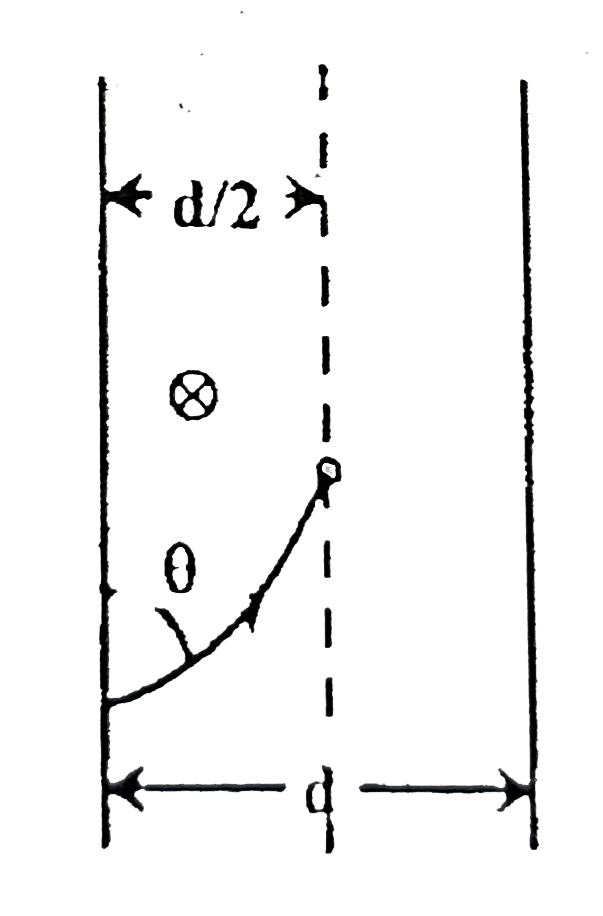A proton of mass m and charge q enters a magnetic field B with a velocity v at an angle θ with the direction of B.The radius of curvature of the resulting path is
mvqB
mvsinθqB
mvqBsinθ
mvcosθqB
The correct Answer is:B
To find the radius of curvature r of the path of a proton moving in a magnetic field at an angle θ, we can follow these steps:
Step 1: Understand the Motion in a Magnetic Field
When a charged particle (like a proton) moves through a magnetic field, it experiences a magnetic force that acts perpendicular to both the velocity of the particle and the magnetic field direction. This force causes the particle to move in a circular path.
Step 2: Resolve the Velocity
The velocity v of the proton can be resolved into two components:
- The component parallel to the magnetic field: vcosθ
- The component perpendicular to the magnetic field: vsinθ
Only the perpendicular component vsinθ contributes to the magnetic force that causes circular motion.
Step 3: Calculate the Magnetic Force
The magnetic force F acting on the proton can be expressed using the formula:
F=q(vsinθ)B
where:
- q is the charge of the proton,
- B is the magnetic field strength,
- vsinθ is the component of the velocity perpendicular to the magnetic field.
Step 4: Relate the Magnetic Force to Centripetal Force
For circular motion, the magnetic force provides the necessary centripetal force. The centripetal force Fc required to keep the proton in circular motion is given by:
Fc=mv2r
where:
- m is the mass of the proton,
- r is the radius of curvature.
Step 5: Set the Forces Equal
Setting the magnetic force equal to the centripetal force gives us:
q(vsinθ)B=mv2r
Step 6: Solve for the Radius r
Rearranging the equation to solve for r:
r=mv2q(vsinθ)B
This simplifies to:
r=mvsinθqB
Final Result
Thus, the radius of curvature of the resulting path is:
r=mvsinθqB
When a charged particle (like a proton) moves through a magnetic field, it experiences a magnetic force that acts perpendicular to both the velocity of the particle and the magnetic field direction. This force causes the particle to move in a circular path.
The velocity v of the proton can be resolved into two components:
- The component parallel to the magnetic field: vcosθ
- The component perpendicular to the magnetic field: vsinθ
The magnetic force F acting on the proton can be expressed using the formula:
F=q(vsinθ)B
where:
- q is the charge of the proton,
- B is the magnetic field strength,
- vsinθ is the component of the velocity perpendicular to the magnetic field.
For circular motion, the magnetic force provides the necessary centripetal force. The centripetal force Fc required to keep the proton in circular motion is given by:
Fc=mv2r
where:
- m is the mass of the proton,
- r is the radius of curvature.
Setting the magnetic force equal to the centripetal force gives us:
q(vsinθ)B=mv2r
Rearranging the equation to solve for r:
r=mv2q(vsinθ)B
This simplifies to:
r=mvsinθqB
Thus, the radius of curvature of the resulting path is:
r=mvsinθqB
Topper's Solved these Questions
- ELECTRODYNAMICSBOOK - RESONANCECHAPTER - ELECTRODYNAMICSEXERCISE - Exercise-2 PART-1
15 Videos
- ELECTRODYNAMICSBOOK - RESONANCECHAPTER - ELECTRODYNAMICSEXERCISE - Exercise-2 PART-2
26 Videos
- ELECTRODYNAMICSBOOK - RESONANCECHAPTER - ELECTRODYNAMICSEXERCISE - Exercise-1 PART-1
81 Videos
- ELECTRO MAGNETIC WAVESBOOK - RESONANCECHAPTER - ELECTRO MAGNETIC WAVESEXERCISE - Exercise 3
27 Videos
- ELECTROMAGNETIC INDUCTIONBOOK - RESONANCECHAPTER - ELECTROMAGNETIC INDUCTIONEXERCISE - A.l.P
19 Videos
Similar Questions
A particle having mass m and charge q is projected with a velocity v making an angle q with the direction of a uniform magnetic field B. Calculate the magnitude of change in velocity of the particle after time t=πm2qB.
View SolutionA particle of mass m and charge +q enters a region of magnetic field with a velocity v, as shown in Fig. 1.93.
a. Find the angle subtended by the circular arc described by it in the magnetic field.
b. How long does the particle stay inside the magnetic field?
c. If the particle enters at E, what is the intercept EF?

View Solution
Knowledge Check
A charged particle of mass m and charge q enters a magnetic field B with a velocity v at an angle θ with the direction of B. The radius fo the resulting path is
AmvsinθqBBmvqBsinθCmvqBDmvtanθqBA charged particle of mass m & charge q enters a zone of uniform magnetic field B with a velocity v making an angle θ with the boundary of the zone, having width d, when the particle penetrates half-way into the zone, the change in energy of the particel is
 Amv22BsinθBBqdmv2sinθCzeroDmvdqBsinθ
Amv22BsinθBBqdmv2sinθCzeroDmvdqBsinθA particle of mass m and charge q enters a magnetic field B perpendicularly with a velocity v, The radius of the circular path described by it will be
ABq/mvBmq/BvCmB/qvDmv/Bq
A charged particle enters into a magnetic field with velocity vector making an angle of 30∘ with respect of the direction of magnetic field. The path of the particle is
View SolutionA charged particle enters a magnetic field B with its initial velocity v making an angle of π4 and B. The path of the particle will be
View SolutionA charged particle enters a magnetic field H with its initial velocity making an angle of 45∘ with H. The path of the particle will be
View SolutionA proton , a deuteron and an α-particle enter a magnetic field perpendicular to field with same velocity. What is the ratio of the radii of circular paths ?
View SolutionA proton of mass m and charge q enters a region of uniform magnetic field of a magnitude B with a velocity v directed perpendicular to the magnetic field. It moves in a circular path and leaves the magnetic field after completing a quarter of a circle. The time spent by the proton inside the magnetic field is proportional to:
View Solution
